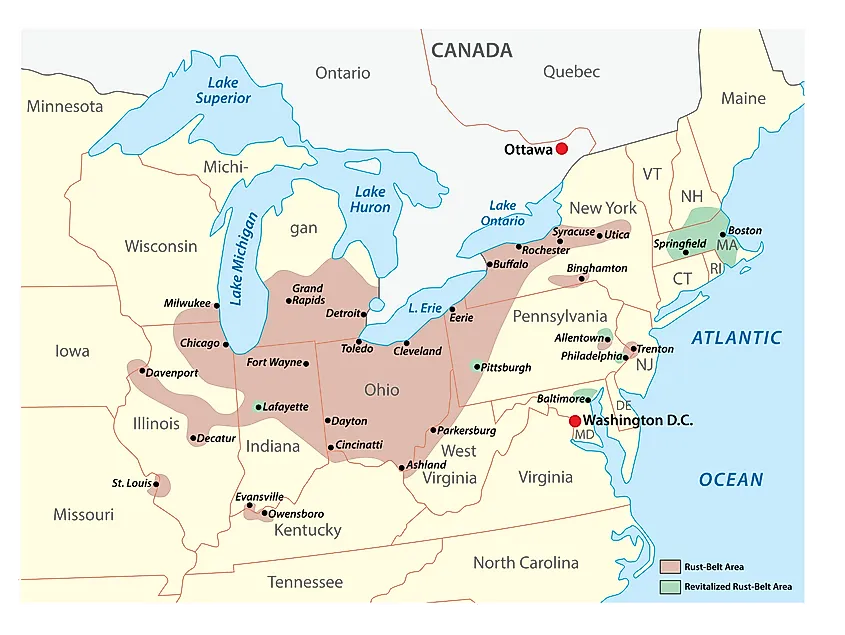

This made US products more expensive for foreigners to buy and also made imports much cheaper for Americans to purchase. High-interest rates attracted wealthy foreign "hot money" into US banks and caused the US dollar to appreciate. From 1979 to 1982, the US Federal Reserve decided to raise the base interest rate in the United States to 19%. These migrants drawn by labor were also accompanied by African Americans during the Great Migration who were drawn by jobs and better economic opportunity.įollowing several "boom" periods from the late-19th to the mid-20th century, cities in this area struggled to adapt to a variety of adverse economic and social conditions. This region for decades served as a magnet for immigrants from Austria-Hungary, Poland and Russia, as well as Yugoslavia, Italy, and the Levant in some areas, who provided the industrial facilities with inexpensive labor. Louis, Youngstown, and Pittsburgh, among others. Soon it developed into the Factory Belt with its manufacturing cities: Chicago, Buffalo, Detroit, Milwaukee, Cincinnati, Toledo, Cleveland, St. After the transportation infrastructure linked the iron ore found in the so-called Iron Range of northern Minnesota, Wisconsin and Upper Michigan with the coking coal mined from the Appalachian Basin in Western Pennsylvania and Western Virginia, the Steel Belt was born. The flourishing of industrial manufacturing in the region was caused in part by the proximity to the Great Lakes waterways, and abundance of paved roads, water canals and railroads. The area was referred to as the Manufacturing Belt, Factory Belt, or Steel Belt as distinct from the agricultural Midwestern states forming the so-called Corn Belt and Great Plains states that are often called the "breadbasket of America". In the 20th century, local economies in these states specialized in large-scale manufacturing of finished medium to heavy industrial and consumer products, as well as the transportation and processing of the raw materials required for heavy industry. and further decreasing The Great Lakes megalopolis shown in orange is associated with the Rust Belt.


Background Change in total number of manufacturing jobs in metropolitan areas, 1954–2002 (figures for New England are from 1958). Others have not fared as well, experiencing economic distress with poverty and the resulting decline in population. Since the mid-20th century, heavy industry has declined in the region, formerly known as the industrial heartland of America.Ĭities closer to the East Coast like the New York metropolitan area, and the Boston area have been able to adapt by diversifying or transforming their economies to shift focus towards services, advanced manufacturing, and high-tech industries. New England was also hard hit by industrial decline during the same era. Louis metropolitan area on the Missouri and Illinois sides of the Mississippi River. The Rust Belt runs southwesterly from Central New York through Pennsylvania, Ohio, West Virginia, Kentucky, Indiana, and then northwesterly through the Lower Peninsula of Michigan, northern Illinois, southeastern Wisconsin, and down through Illinois to include the St. beginning in the 1980s when it was commonly contrasted with the Sun Belt, which was surging. The term "Rust" refers to the impact of deindustrialization, economic decline, population loss, and urban decay on these regions attributable to the shrinking of the once-powerful industrial sector especially including steelmaking, automobile manufacturing, and coal mining. These regions experienced and, in some cases, are continuing to experience the elimination or outsourcing of manufacturing jobs beginning in the late 20th century. GDP peaked in 1953 and has been in decline since, impacting certain regions and cities primarily in the Northeast and Midwest regions of the U.S., including Buffalo, Cincinnati, Cleveland, Detroit, Jersey City, Newark, Pittsburgh, Rochester, Toledo, Trenton, Youngstown, and other areas of New Jersey, Ohio, Pennsylvania, and Upstate New York. manufacturing sector as a percentage of the U.S. The Rust Belt is a region of the United States that experienced industrial decline starting in the 1950s. The company filed bankruptcy in 2001 and was dissolved in 2003. In 1982, however, Bethlehem Steel suspended most of its manufacturing. The rusting steel stacks of Bethlehem Steel in Bethlehem, Pennsylvania, one of the world's largest manufacturers of steel for most of the 20th century.


 0 kommentar(er)
0 kommentar(er)
